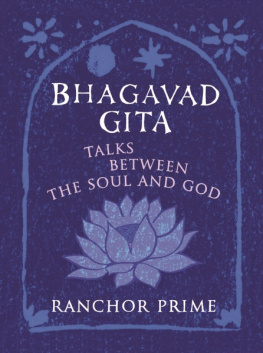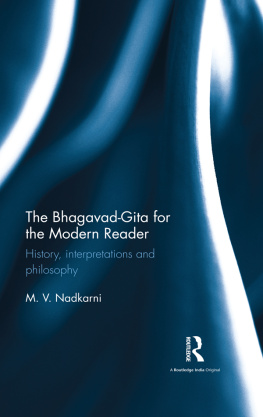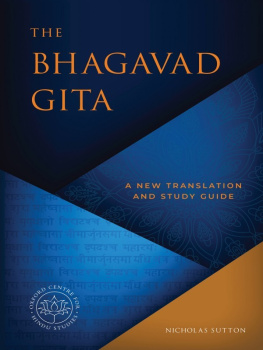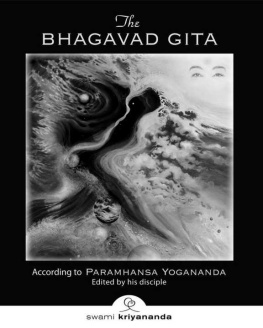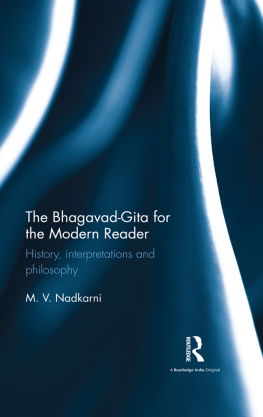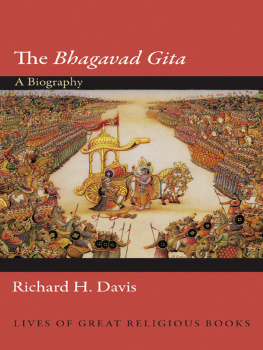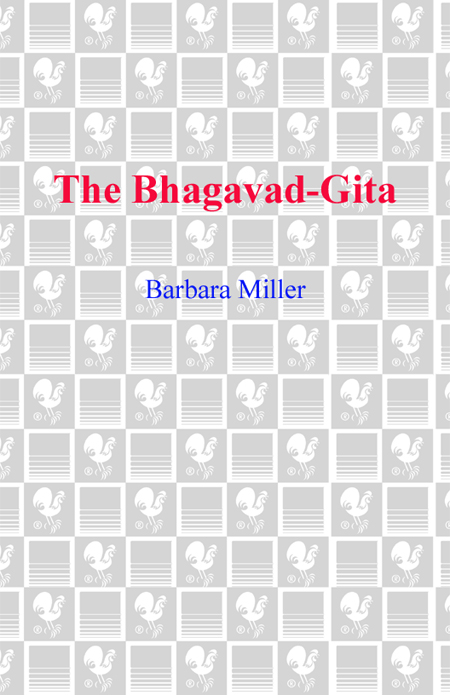For Gwenn
for her sense
of the ways we are
This is the use of memory:
For liberationnot less of love but expanding
Of love beyond desire, and so liberation
From the future as well as the past.
T. S. Eliot,
Little Gidding III,
The Four Quartets
INTRODUCTION
TheBhagavad-Gita: Context and Text
T he Bhagavad-Gita has been the exemplary text of Hindu culture for centuries, both in India and in the West. The Sanskrit title Bhagavad-Gita has usually been interpreted to mean Song of the Lord, but this is misleading. It is not a lyric but a philosophical poem, composed in the form of a dialogue between the warrior Arjuna and his charioteer, the god Krishna.
As we read the Bhagavad-Gita today we can understand the paralyzing conflict Arjuna suffers knowing that the enemies it is his warrior duty to destroy are his own kinsmen and teachers. We can sympathize with his impulse to shrink from the violence he sees in the human condition, and we can learn from the ways Krishna teaches him to understand his own and others' mortality. Krishna's exposition of the relationship between death, sacrifice, and devotion dramatizes the Hindu idea that one must heroically confront death in order to transcend the limits of worldly existence. We may not share Arjuna's developing faith in Krishna's authority or be convinced by Krishna's insistence that one must perform one's sacred duty, even when it requires violence. But if we listen carefully to the compelling arguments and imagery of the discourse, we cannot but hear the voice of a larger reality.
The dramatic moral crisis that is central to the Bhagavad-Gita has inspired centuries of Indian philosophers and practical men of wisdom, as well as Western thinkers such as Thoreau, Emerson, and Eliot. Interpretations of the Gita, as it is commonly referred to in India, are as varied as the figures who have commented on it. From Shankara, the great Hindu philosopher of the eighth century, to Mahatma Gandhi, the leader of India's independence struggle in the twentieth century, each thinker has emphasized the path to spiritual liberation that was suited to his view of reality. These various interpretations reflect the intentionally multifaceted message of Krishna's teaching. The Gita's significance for Hindu life continues to be debated in India today.
Hinduism is not based on the teachings of a founder, such as Buddha, Christ, or Muhammad. It has evolved over centuries through the continual interplay of diverse religious beliefs and practices: popular local cults; orthodox traditions, including the ancient Vedic hymns, the ritual texts of the Brahmanas, and the mystical Upanishads; as well as heterodox challenges from Buddhist and Jain ideas and institutions. Even the word Hindu is a foreign idea, used by Arab invaders in the eighth century A.D. to refer to the customs and beliefs of people who worshipped sectarian gods such as Vishnu and Shiva.
Although the Gita exists as an independent sacred text, its placement within the sixth book of the great Indian war epic, the Mahabharata, gives it a concrete context. The religious and cultural life of the Indian subcontinent, and much of the rest of Asia, has been deeply influenced by the Mahabharata, as well as by the Ramayana, the other ancient Indian epic. Both poems have their roots in legendary events that took place in the period following the entry of nomadic Indo-Aryan-speaking tribes into northwestern India around 1200 B.C. The composition of the epics began as these tribes settled in the river valleys of the Indus and the Ganges during the first millennium B.C., when their nomadic sacrificial cults began to develop into what are now the religious traditions of Hinduism.
The Hindu concept of religion is expressed by the Sanskrit term dharma (sacred duty), which refers to the moral order that sustains the cosmos, society, and the individual. The continual reinterpretation of dharma attests to its significance in Indian civilization. Derived from a Sanskrit form meaning that which sustains, within Hindu culture it generally means religiously ordained duty, that is, the code of conduct appropriate to each group in the hierarchically ordered Hindu society. Theoretically, right and wrong are not absolute in this system; practically, right and wrong are decided according to the categories of social rank, kinship, and stage of life. For modern Westerners who have been raised on ideals of universality and egalitarianism, this relativity of values and obligations is the aspect of Hinduism most difficult to understand. However, without an attempt to understand it, the Hindu view of life remains opaque.
The epics are repositories of myths, ideals, and concepts that Hindu culture has always drawn upon to represent aspects of dharma. As befits their social position as warrior-kings, the figures of the epic heroes embody order and sacred duty (dharma); while their foes, whether human or demonic, embody chaos (adharma). The rituals of warrior life and the demands of sacred duty define the religious and moral meaning of heroism throughout the Mahabharata. Acts of heroism are characterized less by physical prowess than by the fulfillment of dharma, which often involves extraordinary forms of sacrifice, penance, devotion to a divine authority, and spiritual victory over evil. The distinctive martial religion of this epic emerges from a synthesis of values derived from the ritual traditions of the Vedic sacrificial cult combined with loyalty to a personal deity.
Most scholars agree that the Mahabharata was composed over the centuries between 400 B.C. and A.D. 400. Beyond its kernel story of internecine war, it is difficult to summarize. The work has its stylistic and mythological roots in the Rig Veda; its narrative sources are the oral tales of a tribal war fought in the Punjab early in the first millennium B.C. As the tradition was taken over by professional storytellers and intellectuals, many sorts of legend, myth, and speculative thought were absorbed, including the Bhagavad-Gita, which belongs to that layer of the epic which took form around the first century A.D. In its present form the Mahabharata is a rich encyclopedia of ancient Indian culture consisting of over one hundred thousand verses divided into eighteen books. The multiple layers of the text reflect its long history as well as attempts to reconcile conflicting religious and social values.
The epic's main narrative revolves around a feud over succession to the ancient kingdom of Kurukshetra in northern India. The rivals are two sets of cousins descended from the legendary king Bharatathe five sons of Pandu and the one hundred sons of Dhritarashtra. The feud itself is based on genealogical complications that are a result of a series of divine interventions. Pandu had become king because his elder brother, Dhritarashtra, was congenitally blind and thus ineligible for direct succession to the throne. But Pandu was unable to beget offspring because of a curse that forbade him intercourse with his two wives on penalty of death. After a long reign he renounces the throne and retires to the forest, where he fathers five sons (the Pandava brothers) with the help of five gods, and then dies.


